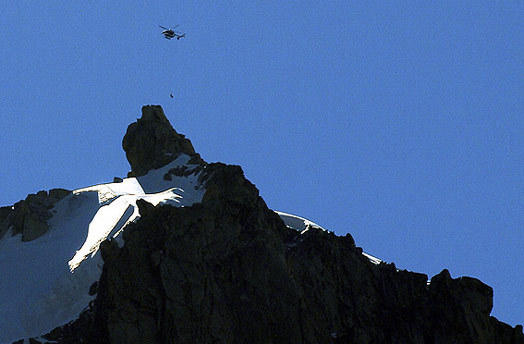
A rescue helicopter on August 4 lifts climbers off the Aiguille du Plan in Chamonix, French Alps. The past month has been one of the most devastating in the Alps’ history, as nearly thirty climbers have perished from various unrelated accidents. [Photo] Menno Boermans
In one month, a series of tragedies in the Swiss and French Alps took the lives of about thirty people.
At the end of July eight climbers were surprised by incoming bad weather while climbing Mont Blanc (4808m) from Chamonix. Lost halfway up the French Normal Route, heavy snowstorms kept the party from finding a way out. Rescue workers from the PGHM (high mountain police) tried to find them in horrible conditions, and were forced down by thunderstorms. Finally there was a small window of clear weather when a helicopter was able to pick up a group of four from the Italian side of the mountain. The other four (one Frenchman and three women from Great Britain, Chile and New Zealand) were found dead the next day.
That same day six German climbers got in trouble on the Italian side of Monte Rosa (4634 m) and were forced to spend the night, without bivy gear, outside in a storm. The next day one woman was found dead and another seriously incapacitated due to hypothermia. At the Grand Combin (4314m) a Polish climber fell to his death, and in the Swiss Bernese Oberland rescue workers saved the lives of six climbers who were stuck near the summit of the Monch. Through a storm they climbed the mountain to find all six shivering in the snow. The helicopter winched some of them; the others descended by foot. The chief of the Grindelwald rescue station said it was one of the most strenuous rescue operations in recent years.
In the week following, two climbers died on the Matterhorn. Both fell to their death while descending via the Hornli Ridge. The same week Air Zermatt, the helicopter rescue service in the Swiss mountains of Wallis, was extremely busy. Many times they successfully brought help, but for some climbers it was too late. At least three fell to their death after stumbling on hiking paths, and two Polish climbers fell several hundred meters from the Allalinhorn mountain near the Swiss village of Saas Fee. In two other accidents, three young Swiss died by falling from the Obergabelhorn, and a tragic accident on the Aletschgletjser took the life of Claude Rey, President of the International Guides Association (IFMGA). He was, early in the morning on July 28, walking from the Konkordiahut towards the glacier, when he fell through a snow bridge on the moraines. Air Zermatt was able to recover his body, but he died later that day in the Hospital of Sitten.

A Chamonix-based PGHM (high mountain police) rescue chopper. The PGHM has been working overtime to accomodate the large volume of rescue calls this summer. [Photo] Menno Boermans
Another accident occurred on Mont Blanc, taking the lives of a French man and his son. They fell through the cornice of the Arete de Bionassay. Some days later a climber was descending through the Grand Couloir of Mont Blanc when he lost his balance and fell about 100 meters. Also dead.
On August 2 another cold front hit the Alps. Two German climbers at the Weismies, above Saas Grund, got in trouble when lightning struck and seriously injured one of them. Air Zermatt rescued them after his partner called for help. Last weekend also was busy for the rescue services. Air Zermatt answered–in two days–more than twenty calls from mountain travellers in trouble, most of them with “only” light injuries. A remarkable number of alpinists were evacuated because they couldn’t or wouldn’t climb further. The PGHM of Chamonix for example winched “stuck” people from hard routes on the Dru and the Grandes Jorasses. Mont Blanc took again three lives last Saturday. The German woman and men were missing for two days when they were found dead near the Grands Mulets. They had tried to take a more difficult variant of the Standard Route. Finally, today, three climbers were hit by falling ice at the Dome des Ecrins, also in the French Alps.
2007 has become one of the darkest summers in the past half-century. Only in 1997 did so many climbers lose their lives in such a short period. The reason is generally unclear. It is known that in some cases, climbers were not well prepared. The group of four who died on Mont Blanc, for example, did not have proper clothing to protect from the elements, and they did not attempt to dig a shelter in the snow. Bruno Jelk, Chief of the Zermatt Rescue Service, confirmed that many climbers this season have entered the mountains without proper equipment and training. He also adds that everyone–even those prepared–must be more careful in the mountains, which are becoming less stable every year due to the changing climate.

Earlier this month Air Zermatt responded to twenty calls, some benign and some severe, in two days. Boermans said that “a remarkable number of alpinists were evacuated because they couldn’t or wouldn’t climb further.” On the left is Bruno Jelk, high mountain rescue specialist. [Photo] Menno Boermans